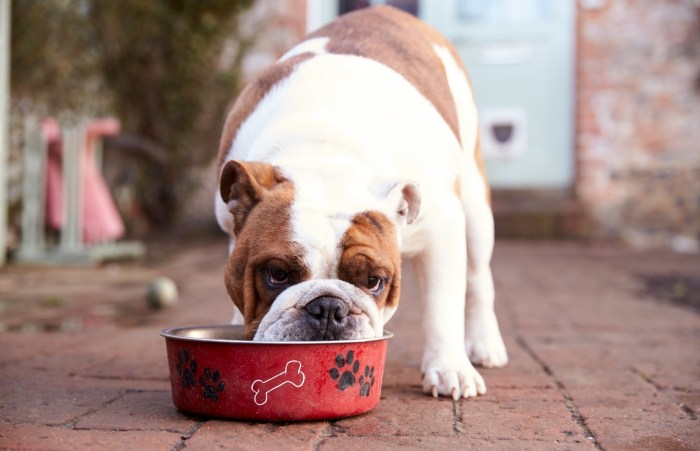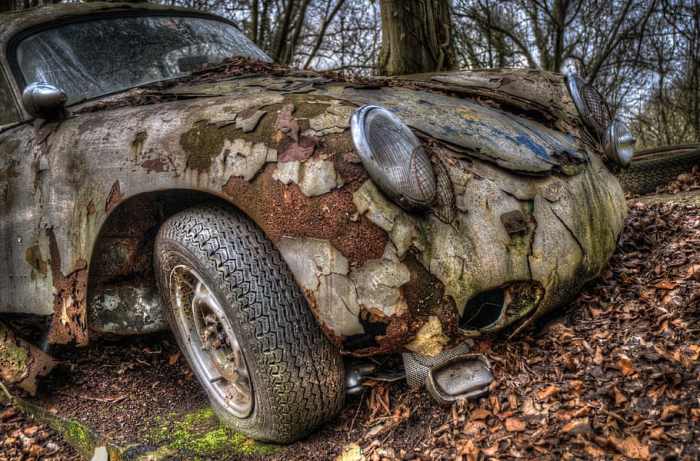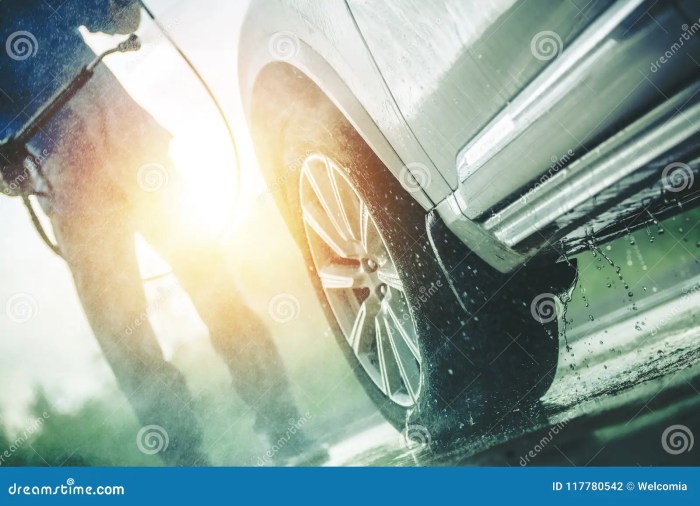El carro muy sucio lávalo, the art of washing a very dirty car, is a task that requires both skill and patience. This comprehensive guide will provide you with all the knowledge and techniques you need to restore your car to its former glory.
From choosing the right detergent to using advanced techniques like foam cannon and clay bar, we’ll cover everything you need to know to achieve a professional-quality finish.
Car Wash Techniques
Washing a very dirty car requires specific techniques to effectively remove stubborn dirt and grime without damaging the paint. Here’s a comprehensive guide to help you achieve a sparkling clean car:
Pre-Washing
Before using any soap or brushes, it’s crucial to pre-wash the car to loosen and remove loose dirt and debris. This step helps prevent scratching the paint during the actual washing process.
- Rinse the car thoroughly with a strong stream of water to remove loose dirt.
- Apply a pre-wash solution or a dedicated car wash soap diluted with water to the entire car, allowing it to dwell for a few minutes.
- Rinse the car again to remove the pre-wash solution and remaining loose dirt.
Washing
Now that the car is pre-washed, you can proceed with the actual washing process:
- Use a soft microfiber wash mitt or sponge to apply car wash soap diluted with water to the car, starting from the roof and working your way down.
- Wash in small sections, rinsing the mitt or sponge frequently to prevent dirt accumulation.
- Use a separate mitt or sponge for the wheels and tires to avoid transferring brake dust and dirt to the paint.
Drying
Once the car is washed, it’s important to dry it properly to prevent water spots and streaks. Use a clean microfiber drying towel or chamois to gently absorb the water.
- Start from the roof and work your way down, patting the car dry rather than rubbing to avoid scratching.
- Use a separate drying towel for the wheels and tires to prevent dirt transfer.
Tips for Removing Stubborn Dirt and Grime
For particularly stubborn dirt or grime, you may need to use additional techniques:
- Use a clay bar to remove embedded contaminants that cannot be removed by regular washing.
- Apply a dedicated tar and bug remover to dissolve and remove tar and bug splatter.
- Use a wheel cleaner specifically designed for removing brake dust and other road grime from wheels and tires.
Avoiding Scratches and Swirls
To avoid scratches and swirls during the washing process, follow these tips:
- Never use abrasive materials such as dish sponges or steel wool.
- Wash the car in the shade to prevent the sun from drying out the soap and water, which can lead to scratching.
- Use a gentle touch and avoid applying excessive pressure when washing or drying.
- Rinse the car thoroughly after each step to remove any remaining dirt or soap residue.
Detergent Selection

Choosing the right detergent is crucial for effectively removing heavy dirt and grime from a very dirty car. Detergents specifically formulated for automotive cleaning offer varying strengths and properties to suit different cleaning needs.
There are two main types of detergents used in car washing: alkaline and acidic.
Alkaline Detergents
- Highly effective at removing heavy dirt, oil, and grease
- Suitable for use on most exterior surfaces, including paint, metal, and plastic
- Can be harsh on some surfaces, so it’s important to dilute them according to the manufacturer’s instructions
Acidic Detergents
- Designed to remove water spots, mineral deposits, and other acidic contaminants
- Less effective at removing heavy dirt and grime than alkaline detergents
- Can be used on glass, chrome, and other delicate surfaces
For very dirty cars, an alkaline detergent is typically the best choice. It will effectively break down and remove heavy dirt and grime, leaving your car looking clean and shiny.
Here are some recommended detergents for removing heavy dirt and grime:
- Meguiar’s Ultimate Wash & Wax
- Chemical Guys Maxi-Suds II
- Turtle Wax Ice Snow Foam
Tools and Equipment

Washing a very dirty car requires the right tools and equipment to achieve optimal results. These tools help loosen dirt, remove stubborn stains, and protect the car’s finish.
Here are the essential tools and equipment you’ll need:
Buckets
- Two buckets are recommended: one for soapy water and one for rinsing.
- Use separate buckets to prevent cross-contamination and scratching the car’s paint.
- Choose buckets with a large capacity to hold enough water for thorough washing.
Wash Mitts or Sponges
- Microfiber wash mitts or soft sponges are ideal for gently cleaning the car’s surface.
- Avoid using abrasive materials like steel wool or dish sponges, as they can scratch the paint.
- Choose wash mitts or sponges specifically designed for car washing.
Brushes
- Brushes with soft bristles are useful for cleaning wheels, tires, and other hard-to-reach areas.
- Choose brushes with angled heads for better access to tight spaces.
- Use a separate brush for the wheels to prevent brake dust from transferring to the car’s body.
Hose and Nozzle
- A garden hose with a nozzle is essential for rinsing the car thoroughly.
- Choose a nozzle with adjustable settings to control the water pressure and spray pattern.
- Start with a gentle spray and gradually increase the pressure as needed.
Drying Towels
- Microfiber drying towels are highly absorbent and effective for drying the car without leaving streaks.
- Use multiple towels to avoid scratching the car’s paint.
- Gently pat the car dry, avoiding rubbing or wiping in circles.
Safety Precautions
Washing a very dirty car can be a hazardous task if proper safety precautions are not taken. The grime, dirt, and chemicals involved in the process can pose risks to your health and well-being. Here are some essential safety measures to consider:
First and foremost, it is crucial to wear appropriate protective gear. This includes gloves, eye protection, and a mask or respirator to prevent the inhalation of harmful fumes and particles. Additionally, wear sturdy, closed-toe shoes to protect your feet from potential spills or sharp objects.
Chemical Handling
Many car washing detergents and cleaners contain harsh chemicals that can cause skin irritation, burns, or eye damage. Always read and follow the manufacturer’s instructions carefully, and avoid mixing different chemicals unless specifically directed. Wear gloves when handling these products, and rinse your skin thoroughly with water if it comes into contact with any chemicals.
Electrical Hazards
Water and electricity do not mix well. When washing your car, ensure that all electrical connections are properly insulated and protected from water. Avoid using power washers or other electrical equipment near water sources or in wet conditions.
Slippery Surfaces
Wet surfaces can be slippery, especially when combined with soapy water. Be cautious when walking around your car during the washing process, and wear shoes with good traction to prevent slips and falls.
Sun Exposure
If you are washing your car in direct sunlight, take precautions to protect yourself from excessive sun exposure. Wear sunscreen, a hat, and sunglasses, and take breaks in the shade as needed to avoid heat exhaustion or sunburn.
Step-by-Step Washing Process
Washing a very dirty car requires a systematic approach to ensure thorough cleaning and optimal results. Follow these detailed steps to restore your car’s pristine condition:
Preparation
Before starting the washing process, gather all necessary tools and equipment, including a hose with a nozzle, car wash soap, wash mitt or sponge, clean microfiber towels, and a bucket for soapy water. Remove any loose debris or dirt from the car’s surface using a soft brush or compressed air.
Rinsing
Begin by rinsing the car thoroughly with clean water from the hose. This step helps remove loose dirt and debris, preventing them from scratching the paint during washing.
Soaping
Fill a bucket with clean water and add the recommended amount of car wash soap. Using a wash mitt or sponge, apply the soapy water to the car’s surface, starting from the top and working your way down. Avoid using harsh detergents or dish soap, as they can damage the paint.
Washing
Use the soapy mitt or sponge to gently wash the car’s surface in small sections. Start with the least dirty areas and move to the dirtier ones. Apply light pressure and use circular motions to effectively remove dirt and grime.
Rinsing
After washing, rinse the car thoroughly with clean water from the hose. Ensure all soap residue is removed to prevent streaks or spots from forming when the car dries.
Drying
Use clean microfiber towels to dry the car’s surface. Start with the least wet areas and move to the wetter ones. Pat the car dry instead of rubbing to prevent scratching. For best results, use a separate towel for each panel or section of the car.
Troubleshooting Common Issues
Washing a very dirty car can present various challenges. This section addresses common issues that may arise during the process and provides troubleshooting tips to resolve them effectively. By understanding these issues and their solutions, you can prevent them from recurring and ensure a successful car wash.
To get your very dirty car washed, you need to find a car wash. But if you’re looking for a more mathematical challenge, you can try to find ef in the trapezoid . It’s a fun puzzle that will test your geometry skills.
And when you’re done, you can go back to washing your car.
Removing Stubborn Stains, El carro muy sucio lávalo
- Use a specialized stain remover or a mixture of baking soda and water.
- Apply the solution to the stain and let it sit for a few minutes.
- Scrub the stain gently with a soft brush or sponge.
- Rinse the area thoroughly with water.
For particularly stubborn stains, consider using a clay bar to remove embedded dirt and contaminants.
Dealing with Water Spots
- Use a vinegar and water solution (1:1 ratio).
- Apply the solution to the water spots and let it sit for a few minutes.
- Wipe the area clean with a soft cloth.
- Rinse the area thoroughly with water.
To prevent water spots, dry your car immediately after washing it, using a clean microfiber towel or chamois.
Preventing Future Issues
- Wash your car regularly to prevent dirt and grime from accumulating.
- Use high-quality car wash products designed for your specific vehicle.
- Avoid using harsh detergents or abrasive brushes.
- Dry your car thoroughly after washing to prevent water spots.
By following these troubleshooting tips and preventative measures, you can effectively address common issues when washing a very dirty car and ensure a clean and well-maintained vehicle.
Advanced Techniques

To achieve a professional-quality finish on a very dirty car, consider employing advanced techniques such as foam cannon and clay bar applications.
A foam cannon generates a thick layer of foamy suds that clings to the car’s surface, effectively loosening and lifting dirt and grime. This method enhances the cleaning power of your detergent and minimizes the risk of scratching the paint during the wash process.
Clay Bar
A clay bar is a specialized tool used to remove embedded contaminants such as tar, tree sap, and industrial fallout from the car’s surface. It is made of a fine-grade clay that gently removes these contaminants without damaging the paint.
Using a clay bar after washing and drying the car ensures a smooth and glossy finish.
Maintenance and Prevention: El Carro Muy Sucio Lávalo

Regular car washing is crucial to prevent dirt and grime buildup that can damage your car’s paint and finish. It removes corrosive contaminants, road salt, and bird droppings that can cause rust and fading. Additionally, a clean car enhances visibility, making driving safer.
To maintain a clean car and prevent future stains and damage, follow these tips:
Cleaning Frequency
- Wash your car every 1-2 weeks, or more frequently if exposed to harsh conditions like rain, snow, or road salt.
Detailing Services
- Professional detailing services can restore your car’s showroom shine and protect it from the elements. They typically include thorough cleaning, waxing, and polishing.
Protective Coatings
- Ceramic coatings and waxes create a protective layer on your car’s paint, making it more resistant to scratches, UV rays, and environmental damage.
Questions and Answers
How often should I wash my car?
It depends on the climate and how often you drive. In general, it’s a good idea to wash your car every two weeks.
What’s the best way to remove stubborn stains?
Use a dedicated stain remover or a mixture of baking soda and water. Apply the solution to the stain and let it sit for a few minutes before scrubbing.
How can I prevent water spots?
Use a drying towel or chamois to dry your car immediately after washing. You can also apply a sealant or wax to protect the paint.